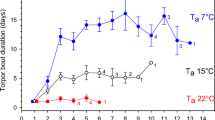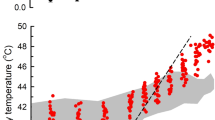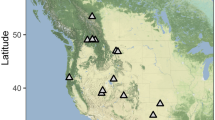Abstract
Torpor is a natural state in which animals show a substantial and controlled reduction of body temperature to conserve energy1,2. A few small birds (weighing less than 80 g) are known to use it as a survival strategy in winter, but we have discovered that a large bird, the Australian tawny frogmouth, which weighs 500 g, can also enter this state. This surprising finding increases the size of birds known to use natural torpor by almost tenfold, suggesting that avian torpor is more widespread than is commonly believed, enabling birds to stay in their territory throughout the year.
Similar content being viewed by others
Main
Small endothermic birds and mammals have enormous food requirements because of the fast metabolic rate that is necessary to regulate a high body temperature (Tb). When this high metabolic rate is unsustainable, for example in periods of adverse weather and/or food shortage, many small mammals (body mass 2–10,000 g) survive by entering a state of torpor1,2,3. The study of torpor in birds has so far been restricted to species weighing less than 80 g (refs 2,4,5), and rather than using torpor to overcome adverse conditions, birds may migrate to avoid them. However, many birds are sedentary and often rely on ephemeral, weather-dependent food sources — so how do they overcome periodic energy bottlenecks?
To answer this question, we investigated whether the Australian tawny frogmouth (Podargus strigoides; Fig. 1), a sedentary bird which feeds mainly on arthropods, uses torpor in the wild. The study wasconducted from the Australian autumn to summer in an open woodland of Eucalyptus and Acacia at 1,000 m altitude in a cool temperate area near Armidale, New South Wales. We captured seven frogmouths and fitted them with temperature-sensitive transmitters (calibrated to the nearest 0.1 °C) weighing 3 g. All birds received an external backpack-style transmitter4 (long range) to measure skin temperature (Tskin), and three birds had a second internal transmitter (short range), to measure core Tb and to determine Tb−Tskin differentials, implanted under general anaesthesia. Transmitter signals were recorded at 10-min intervals for up to nine months6.
All individuals entered torpor in winter: Tb fluctuated around 38–40 °C during activity and fell to about 36 °C during the rest phase, with a lower limit of 34 °C. On cold (less than 7 °C) winter nights in June–August, Tb fell below 34 °C on 202 of 462 observation days (44%). The minimum Tb recorded by an internal transmitter was 29.1 °C, the lowest Tb calculated from Tskin and the Tb− Tskin differential was 27.2 °C, and the mean minimum Tb for the seven birds was 29.0±1.0 °C. Birds usually entered torpor after a brief phase of activity in the evening ( Fig. 2), became active again near sunrise and frequently entered a second bout of torpor after they had flown to their day roost. Dawn torpor was briefer (3.5±1.2 hours) than night torpor (7.0±1.2 hours) and was often terminated by passive rewarming in the sun.
Our study shows that the large frogmouth regularly enters torpor in winter. We argue that the use of torpor enables the bird to survive in a wide range of habitats and to remain resident in its territory throughout the year7, despite feeding on arthropods. Because torpor occurs in this large bird and because birds are more diverse and smaller on average than mammals, we predict that avian torpor is much more common than is currently believed.
References
Lyman, C. P., Willis, J. S., Malan, A. & Wang, L. C. H. Hibernation and Torpor in Mammals and Birds (Academic, New York, 1982).
Geiser, F. & Ruf, T. Physiol. Zool. 68, 935–966 (1995).
Cossins, A. R. & Barnes, B. M. Nature 382, 582–583 (1996).
Brigham, R. M. Physiol. Zool. 65, 457–472 (1992).
Reintertsen, R. E. Polar Res. 1, 269–284 ( 1983).
Körtner, G. & Geiser, F. Oecologia 123, 350–357 (2000).
Körtner, G. & Geiser, F. J. Zool. Lond. 248, 501–507 ( 1999).
Author information
Authors and Affiliations
Corresponding author
Rights and permissions
About this article
Cite this article
Körtner, G., Brigham, R. & Geiser, F. Winter torpor in a large bird. Nature 407, 318 (2000). https://doi.org/10.1038/35030297
Issue Date:
DOI: https://doi.org/10.1038/35030297
This article is cited by
-
The decoupled nature of basal metabolic rate and body temperature in endotherm evolution
Nature (2019)
-
Frequent nocturnal torpor in a free-ranging Australian honeyeater, the noisy miner
The Science of Nature (2019)
-
Seasonal body mass fluctuations of captive Tawny Frogmouths (Podargus strigoides) are consistent with seasonal heterothermy
Journal of Ornithology (2018)
Comments
By submitting a comment you agree to abide by our Terms and Community Guidelines. If you find something abusive or that does not comply with our terms or guidelines please flag it as inappropriate.





